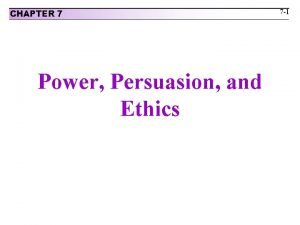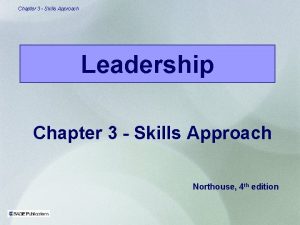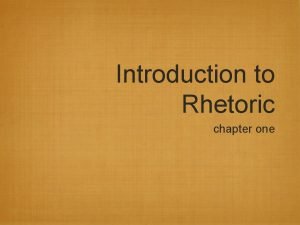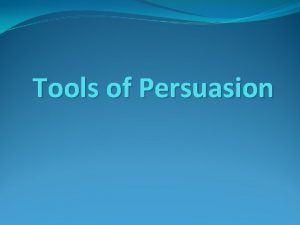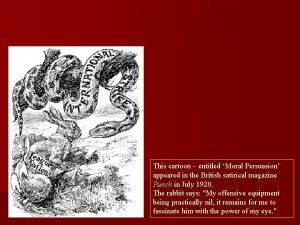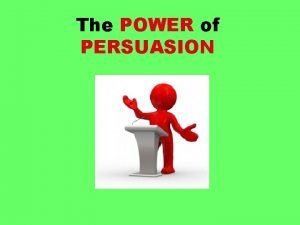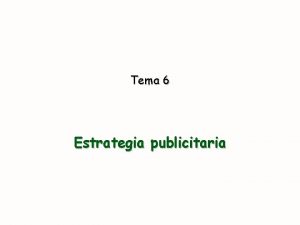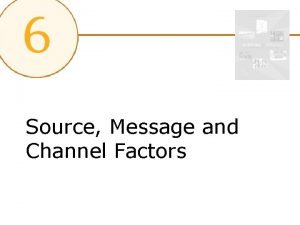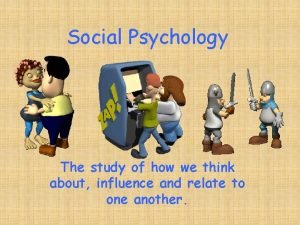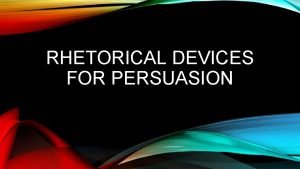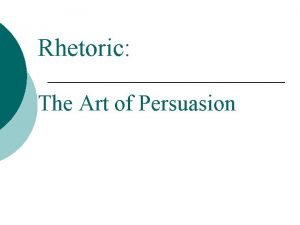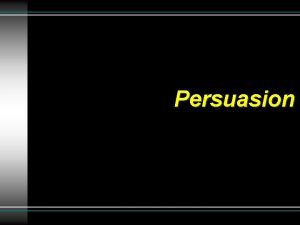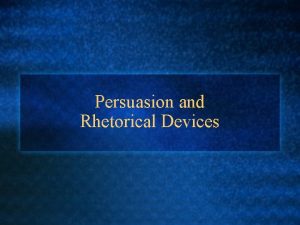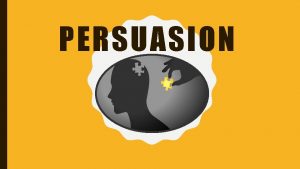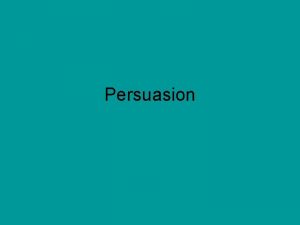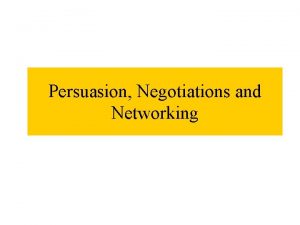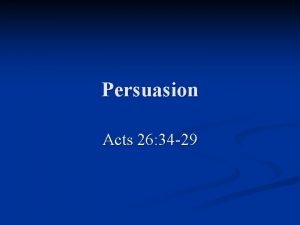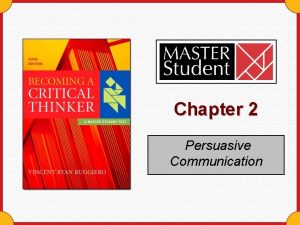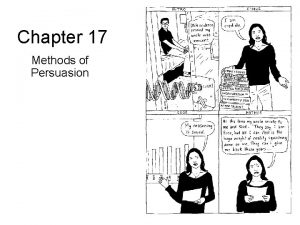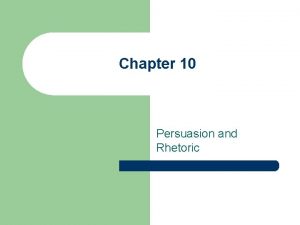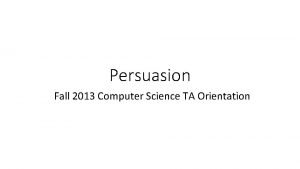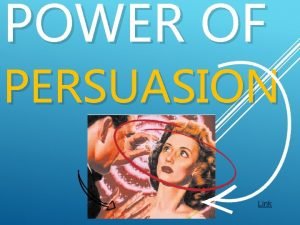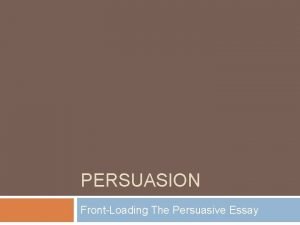Chapter 9 Persuasion What is persuasion As defined


















- Slides: 18

Chapter 9 Persuasion

What is persuasion? As defined by the Webster’s II New Riverside Dictionary persuasion is, “the act or process of persuading, or the state of being persuaded” (511). l Persuasion is an attempt to change an individual’s mind on a particular issue, to make a listener feel a certain way, or to make some appeal to logic, emotions, identification with the speaker, or any combination.

Science of Persuasion l http: //www. youtube. com/watch? v=c. Fd. Cz. N 7 RYbw

How does one persuade? l A persuasive speaker must develop CRITICAL THINKING SKILLS. l These are skills related to making judgments and decisions

Skills in critical thinking Perceiving: This is the ability to listen, observe, compare and contrast, and interpret data l Arranging: group perceptions, classify them, discover patterns, or order. l Inquiring: ask questions and analyze meanings in responses. l

Skills in critical thinking Inferring: the ability to recognize underlying assumptions, make generalizations, and understand cause effect relationships l Reasoning: having the ability to make decisions, exercise judgments, arrive at conclusions, and recognize specific examples l

Fallacies in Logic Oversimplifying the issue- to distort the truth by presenting too limited a range of options l Begging the question- stating a position that needs to be proved as though it has already been proved l Misleading statistics- ratios and percentages that are factual but do not prove what the speaker claims they prove. l

Fallacies in Logic Reasoning backward- assumes that anyone who has the characteristics of a group must belong to that group. l False analogy- A comparison of one thing to another that does not make sense because things being compared are too dissimilar. l

Fallacies in Logic Red Herring- Presenting a new topic in order to distract from the inability of an individual to prove a point. l Celebrity testimony- The statements of someone famous to prove that something is true and correct, even though they may have no true understanding of the topic. l

Fallacies in Logic l Bandwagon- Persuading through the argument that because the majority is, that everyone should be.

Appeals to Logic take on two forms: l Inductive reasoning- a speaker begins with a very specific point and works to a general conclusion. l Deductive reasoning- a speaker begins with a general idea and works to a specific conclusion. l

Appeals to Emotion Appeals to emotion focus on the following: l 1. Physical needs- life and health of an individual’s body. The needs for food, shelter, and freedom from physical pain. l 2. Psychological needs- involve an individual’s inner life. The need for love and belonging. l

Appeals to Emotion l Social needs- focus on the individual’s need to feel part of the group. l When using appeals to emotion l l l Consider the purpose and the topic Know your audience Consider building up to your thesis rather than stating it right at the beginning. Use vivid language Avoid the fallacies.

Using Identification l Be sure to use ethical appeals. This allows the audience to associate with and trust the speaker. l Establish your own credibility. l Evoke the goodwill of your listeners. l Speak with genuine self confidence and enthusiasm.

Using Identification with appeals to Logic and Appeals to Emotion The ancient Greeks advised that the persuasive speakers task was to discover all the available means of persuasion. l In other words combine all the elements. Identification, Appeals to Logic, and Appeals to Emotion to make arguments. l l http: //www. youtube. com/watch? v=r. Fc. CFE e. OEeg

Using Identification with appeals to Logic and Appeals to Emotion l Text p. 348 -352 Read as a class l Pp. 352 -353 #1 -10 respond individually

Using Identification with appeals to Logic and Appeals to Emotion l In essencel 1. Use logical appeals in presenting points that are common sense or fact. l 2. Use emotional appeals in presenting main points that are based on basic human, physical, psychological, or social needs. l 3. Use techniques that will allow identification with you as a speaker. Establish credibility, self confidence, and evoke listener’s goodwill.

Speech Time!! l See page 354 as a guide.
 Which greek philosopher defined the art of persuasion
Which greek philosopher defined the art of persuasion A collection of well-defined objects is called
A collection of well-defined objects is called Persuasion chapter 9
Persuasion chapter 9 Persuasion chapter 7
Persuasion chapter 7 The skills approach is primarily
The skills approach is primarily How is rhetoric defined in this chapter?
How is rhetoric defined in this chapter? Ranks model of persuasion
Ranks model of persuasion Tools of persuasion
Tools of persuasion Snake and rabbit meaning
Snake and rabbit meaning Elements of persuasion
Elements of persuasion Persuasión instintiva
Persuasión instintiva What is persuasion theory
What is persuasion theory Persuasive matrix
Persuasive matrix Peripheral route persuasion
Peripheral route persuasion Cognitive dissonance
Cognitive dissonance Central route persuasion
Central route persuasion Rhetorical devices
Rhetorical devices Logos pathos ethos kairos
Logos pathos ethos kairos The target person complies
The target person complies



